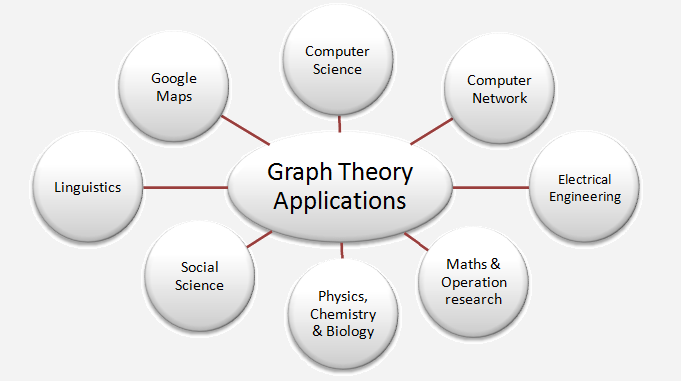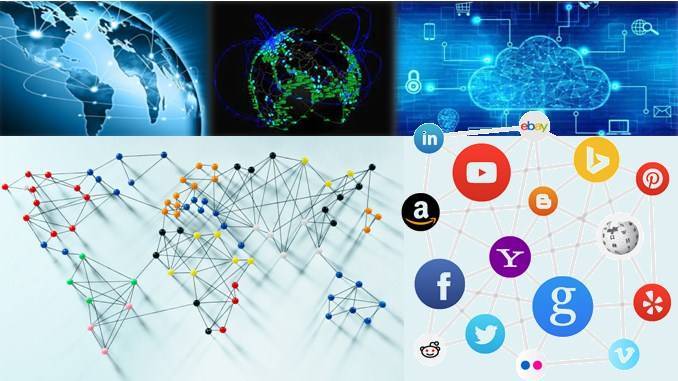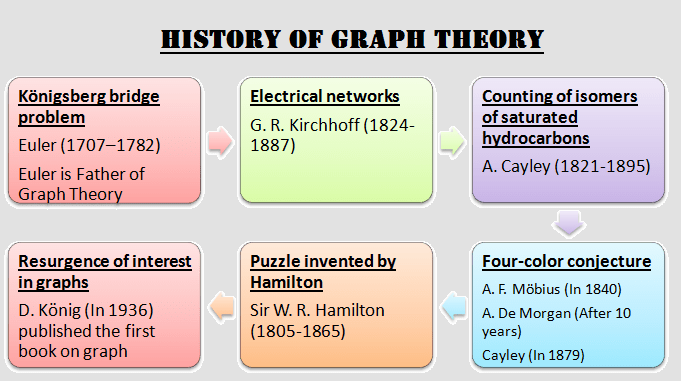
Graph Theory Applications:
Graph theory, due to its intrinsic simplicity, has a lot of applications in computer science, computer networks, engineering science, social science, mathematics, physics, chemistry, biology, genetics, economics, logistics, linguistics, sociological structures, data structure, artificial intelligence, pattern recognition, cybernetics, reliability theory, computer fault diagnosis, and many other fields. Graph theory has also been used in studying the structure of computer memory and studying Martian canals. Thus, the list of graph theory applications continues to grow.
The first point that should keep in mind is that a graph is a mathematical structure that allows representing everyday problems graphical manner. Because of its applications in various fields including computer science (algorithms and computations), electrical engineering (communications networks and coding theory), operations research (scheduling), and biochemistry (genomics), graph theory is quickly becoming a part of the mainstream of mathematics.
Graph theory is a branch of mathematics that is also applied in computer science. It is based on both, discrete mathematics as well as applied mathematics. In this way, it is able to enclose a variety of concepts.
The following are some examples of graph theory applications:
1. Graph Theory Applications in Computer Science:
In computer science, a graph is used to represent networks of communication, data organization, computational devices etc. Graphs are used to describe the computation flow. Graph transformation systems use in-memory graph manipulation based on rules. Graph databases allow for the transaction-safe, persistent storage and querying of graph-structured data.
♦ Graph theory is also used for the study of algorithms, for example,
- Dijkstra’s Algorithm – Dijkstra’s algorithm efficiently finds the shortest path between two vertices. A lot of applications of the real world are developed on this basis.
However, there are numerous other applications for routing problems also. For example, consider the minimum spanning tree problem. The aim is to find the lowest total weight set of connections between the vertices such that there is a path in the graph from every vertex to every other vertex. Kruskal’s or Prim’s algorithms can be used to accomplish this efficiently. The electricity network between hubs is a real-world example of this. There are lots of possible connections, but not all of them are required. Choosing the connections of the least spanning tree will reduce the costs.
- Kruskal’s Algorithm – Kruskal algorithm is a method for finding the shortest spanning tree in a given graph, both by hand and by computer.
- Prim’s Algorithm – Prim is another algorithm that does not need to list all edges in order of nondecreasing weight or to check at each step, if a newly selected edge forms a circuit.
♦ Graph theory is also used in computer programming.
Since the early days of computer programming, analysing a given computer programme has been a significant problem. A programme can be represented as a digraph, which is very convenient. Each vertex represents a programme block, and each edge (νi, νj) represents a possible transfer of control from the last instruction in programme block νi to the first instruction in programme block νj. This type of digraph is known as a programme digraph. A programme digraph is a simplified version of a flow chart in which the boxes have been shrunk to vertices and the arrows have been transformed into edges.
2. Graph Theory Applications in Computer Network:
- The principles of graph theory govern the relationships between interconnected computers in the network.
A topology in computer networks is used to explain how a network is physically connected as well as the logical flow of information in the network. In other terms, a topology primarily describes how devices are linked and interact with each other using communication links.
- Networks of communication are represented by using graph theory. Graphs are also used to describe the computation flow. Network security also makes use of graph theory.
- For any GSM (Grouped Special Mobile) mobile phone network, the vertex colouring algorithm can be used to assign at most four different frequencies. The vertex colouring algorithm is used to find a suitable four-color colouring for the map.
3. Application of Graph Theory in Electrical Engineering:
Graph theory concepts are widely used in the design of circuit connections in Electrical Engineering. These circuit connections are referred to as topologies.
[Topology – In other words, the arrangements of a communication network’s elements are called topologies. The topology of a network is studied through its graphs. The star, bridge, mesh, tree, ring, circular, hybrid, series, and parallel topologies are just a few examples of topologies, each of which consists of different configurations of nodes and links. The best network topology for each business is determined by its size, scale, goals, and budget.]
Because there are only a few different types of electrical elements, the variations in networks are primarily caused by variations in topology. Thus, electrical network analysis and synthesis are mainly the studies of network topology. In drawing a graph of an electrical network, regardless of the nature and size of the electrical elements, junctions are denoted by vertices, and branches (that contain electrical elements) are denoted by edges.
4. Application of Graph Theory in Mathematics:
Graphs are useful in geometry and certain aspects of topology, such as knot theory, in mathematics.
Operation research is a significant area of study in mathematics. The minimum cost path (cheapest route) and the scheduling problem are two examples of useful applications in operation research, which are solved by graph theory.
♦ Application of Graph Theory in Operation Research (OR):
The concepts of graph theory are widely used in Operation Research like modelling, transportation, network activity, game theory etc.
- A large number of combinatorial problems are solved using network activity.
- The planning and scheduling of large complex projects are one of the most popular and successful applications of networks in operation research. PERT (Project Evaluation Review Technique) and CPM are two of the most well-known problems (Critical Path Method).
- To find the best way to perform specific tasks in competitive situations, game theory is applied to problems in engineering, economics, war science, etc. In this case, the vertices represent the positions and the edges represent the movements.
5. Applications of Graph Theory in Science:
Graph theory is also useful in physics, chemistry, biology and conservation efforts.
♦ Application of Graph Theory in Physics and Chemistry:
- Graph theory is also used in chemistry and physics to study molecules, because graphs represent a substance’s molecular and chemical structures, etc.
- A graph can also be used to construct the molecular structure and lattice of any molecule. It also aids in showing the bonding relationship between atoms and molecules, as well as comparing the structure of one molecule to another.
- With the help of graphs, the 3D structure of complicated simulated atomic structures can be quantitatively studied by gathering data on graph-theoretic properties related to atomic topology.
- Graphs in statistical physics can represent local connections between interacting parts of a system, as well as the dynamics of a physical process on such systems.
♦ Application of Graph Theory in Biology:
- In the field of biology, graph theory is used to map out networks of genes and proteins, and analyze the interactions between different components.
- The DNA structure of an organism, biological networks, neural networks etc., are represented by graphs.
- Nodes in biological networks represent bimolecular such as genes, proteins or metabolites, and edges connecting these nodes indicate functional, physical or chemical interactions between the corresponding bimolecular.
- Graph theory is also used in Metabolic networks and transcriptional regulation networks.
- Graph theory is also useful in PPI (Protein-Protein interaction) networks and characterizing drug-drug target relationships.
- This can be used to understand how diseases spread, or to develop treatments for diseases.
6. Applications of Graph Theory in Social Science:
Sociology makes extensive use of graph theory also. For example,
- Using graphs of acquaintanceship and friendship to describe whether or not people know each other.
- Using social network analysis software to investigate rumour spreading or to assess actors’ reputations.
- Using the influence graphs model to influence the behaviour of others by certain individuals.
- Using the collaboration graphs to examine whether two people collaborate in a special way, such as working in a team together.
- Using a sociogram to represent relationships between people in a society or group, where a sociogram is a digraph (directed graph) that represents a person’s social connections. In a sociogram, vertices denote members and directed edges denote relationships. Anthropologists have studied a number of tribes and classified them based on their kinship structures.
7. Application of Graph Theory in Linguistics:
Linguistics is the science of language, and it includes semantics, syntax, phonetics, phonology, morphology, pragmatics, historical linguistics, etc. In linguistics, graphs are used to depict parsing diagrams. The vertices denote words and word strings, while the edges denote certain syntactical relationships between them.
A set of words (vocabulary) and a set of rules (grammar) for forming strings (sentences) define a language. That is, the language is a collection of all legally generated strings. In computational linguistics, one problem is to identify whether a given string belongs to a language with a given vocabulary and grammar.
- In linguistics, graphs are used mostly for the parsing tree of a language and the grammar of a language. (A rooted, ordered tree that represents a string’s syntactic structure is called a parsing tree).
- Semantic networks are used within lexical semantics, particularly when applied to computers because the term modelling is easier to mean when a given word is understood in terms of related words.
- Phonology and Morphology methods are frequently used in the analysis of language as a graph.
- It is used to map out the different relationships between words in a language, and to study how languages evolve over time.
8. Application of Graph Theory in Google Maps:
Graph theory is used to find the shortest route in a network or on a road. For example, graph theory is used to find the shortest path to the house by GPS. In Google Maps, different locations are represented as vertices or nodes, and roads are represented as edges, with graph theory used to find the shortest path between two nodes.
Graph theory has applications in many other fields as well, such as economics, sociology, and psychology. Its usefulness and versatility make it a valuable tool for solving real-world problems.
Read Also: Application of Graph Theory in Real Life
There can be many other applications of graph theory that we might have forgotten in this article. If you want to tell us more about this topic, ‘Please Comment’.
(Source – Various books from the college library)
Tags: graph theory and its applications, graph theory with applications to engineering and computer science, chemical applications of graph theory, application of graph theory in real life, real world applications of graph theory, application of graph theory in various fields
Copyrighted Material © 2019 - 2024 Prinsli.com - All rights reserved
All content on this website is copyrighted. It is prohibited to copy, publish or distribute the content and images of this website through any website, book, newspaper, software, videos, YouTube Channel or any other medium without written permission. You are not authorized to alter, obscure or remove any proprietary information, copyright or logo from this Website in any way. If any of these rules are violated, it will be strongly protested and legal action will be taken.



Be the first to comment